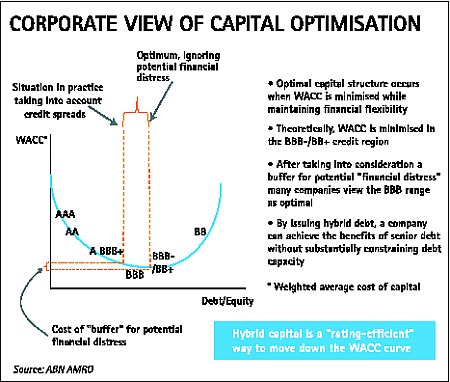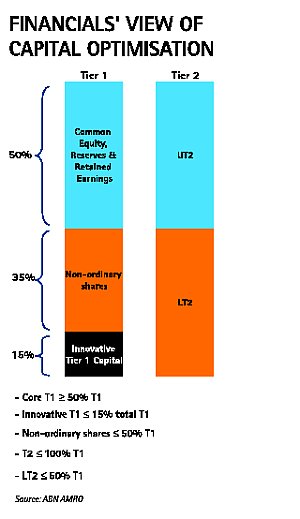Matthew Curran and Ronan Donohue of ABN AMRO explore the increasing appetite for hybrid capital among corporates attracted by the increased financial flexibilityit provides.
Hybrid capital, long the preserve of financial institutions, has started to hold real appeal for a growing number of European corporates as they contemplate their financial strategy.
Although hybrid capital has been undertaken selectively by corporates for some time, during 2003 a number of deals were completed with the specific intention of gaining enhanced financial flexibility from the ratings agencies. Two issues in particular, launched in the primary Eurobond markets last year, underpin much of the renewed interest in this product. German engineering company Linde completed a E400m 6% perpetual non-call 10 transaction, while Michelin did a 6.375% E500m 30-year non-call 20 issue.
On closer examination of the key structural terms and benefits of hybrid capital, many corporates are starting to ask whether they too could utilise such capital in their balance sheet to similar effect. The answer, however, is highly dependent on the specific circumstances facing a given corporate and a tight evaluation of its strategic objectives.
Back to the future
To understand the future drivers of this market, we need to delve deeper into the past. Hybrid capital technology goes back to the drive by financial institutions to hold cheaper forms of capital to support regulatory requirements. For European banks, this requirement goes back to the Bank for International Settlements capital
criteria, particularly the 1998 ruling clarifying acceptable Tier 1 capital structures. European insurers trace their involvement in this market to the life and non-life directives of the early 1990s. In each case, capital securities were developed that enabled the issuer to obtain a tax deduction at the same time as absorbing losses on a going concern basis. The ability to write off the servicing cost of the obligation against tax significantly lowers the overall cost of maintaining this buffer.
In addition to satisfying regulatory requirements, some of these structures were also devised to comply with the particular requirements of the ratings agencies, with Standard & Poor’s (S&P) exerting a strong influence on the way many insurance companies have structured their deals. Although Moody’s uses the same sliding criteria in terms of equity credit for both banks and insurers, S&P, like the regulatory authorities, awards 100% equity credit up to defined limits if their specific structuring stipulations are met.
For financials, the whole question of capital optimisation largely boils down to maximising the permissible regulatory and ratings buckets. The situation for corporates is more complex as they only receive partial equity credit from the rating agencies and the fixed charge coverage ratio will weaken due to the higher coupon associated with hybrid capital. While the Linde and Michelin transactions were fairly vanilla in structural terms, higher equity credit is obtainable for more complex structures, including features such as non-cumulative coupons and/or a convertible component to the deal.
Expensive debt or cheap equity?
Depending on your view, therefore, hybrid capital is either expensive senior debt or cheap equity. As you might expect given the name “hybrid”, the answer lies somewhere in the middle.
Conventional business school theory attributes importance to weighted average cost of capital (WACC) and the ability to increase shareholder value by minimising it. An increase in the proportion of debt versus equity in a company’s capital structure generally reduces WACC, provided reasonable gearing is maintained. Hybrid capital, however, has a higher servicing cost than senior debt. Consequently a senior note issue has a more beneficial impact on WACC than a hybrid capital issue, so, on the face of it hybrid still appears to be sub-optimal.
Further insight is gained by speaking to the ratings agencies, which also give credit to the broader strategic aims of the deal. For example, at the time of its issue, Linde made clear its intention to reduce its leverage and gained some recognition for the very public commitment to do so, quite apart from the balance sheet benefits associated with the loss absorption features. A hybrid issue undertaken in pure isolation may struggle to articulate its benefits, but much less so when viewed as part of a package aimed at setting the company on a new course.
The ratings agencies are also keen to emphasise the value of softer issues in arriving at the appropriate degree of equity credit. One such issue is “replacement language”. By undertaking only to call the bonds with the proceeds of an issue of similar or better capital, other things being equal, a corporate may obtain additional equity credit. Such an undertaking can also act to balance a call-and-step-up feature, which is seen as a soft maturity by the agencies, but required nonetheless, by institutional investors.
Another example of softer criteria exerting a strong influence on the equity credit equation is the treatment of deferral language in certain retail-placed deals. S&P has stated that it gives greater credence to deals placed outside an issuer’s home market as it believes there may be a reluctance to defer payments to domestic retail investors for reputational reasons.
The view from the buy-side
Although hybrid capital plays a very different role for corporates than it does for financial institutions, corporates have gained from investor familiarity with similar products issued by financial institutions. Overall, however, it has been many of those investors already comfortable with an issuer’s senior debt, but with an appetite for yield and long-dated assets, that have signed up to recent corporate issues.
The background to this appetite stems from investor appreciation that the probability of default is the same for senior and subordinated debt, but the yield is compensation for the higher loss-given-default of the latter. On this basis, the decision to invest boils down to being comfortable with the credit. As this is the same equation for investing in senior debt, buyers, familiar with the overall subordinated spectrum tend to prefer the enhanced yield.
More importantly, since 2001 many structures were stress-tested by practical events. During this period, holders of hybrid capital have had to contend with numerous events that caused significant deterioration in secondary market conditions. As well as September 11, corporate governance issues, as well as global equity market meltdown and the associated impact on the solvency condition of the insurance sector (particularly life), demonstrated how robust hybrid capital structures really are. Investors were emboldened by the fact that no major hybrid capital issuer has defaulted or even passed on an interest payment throughout this period.
Financial flexibility
The attractions of hybrid capital chiefly relate to the increased financial flexibility that comes with the equity credit given to such instruments by the credit rating agencies and, in the case of certain structures involving preference shares, can enable a company to side-step restrictive bank covenants. It is also a function of the WACC analysis favoured by many corporates and their appetite for a number of softer issues. On the whole, with the buy-side on board, issuers can now at least undertake a meaningful cost-benefit analysis and seriously consider a hybrid component to their capital structure.
Matthew Curran is Executive Director, Financial Markets Advisory, ABN AMRO Ronan Donohue is director, regulatory capital structuring for financial institutions, Financial Markets Advisory, ABN AMRO




